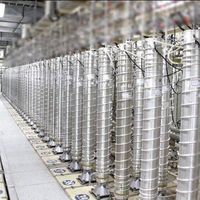Exclusive: Israeli Source Says Iran Boosting Drone Deliveries To Proxies
An Israeli source has told Iran International that Iran plans to make drone strikes the focus of its offensive activities across the region in the near future.
The source, who did not want to be named, said in an exclusive interview that in recent months Iran’s Revolution Guard Corps (IRGC) has been increasing delivery of drones to its proxies in the region and beyond.
He noted that now Iranian-backed forces in Iraq, Syria, Yemen, as well as Hezbollah in Lebanon have received these drones, adding that they were also sold to Venezuela.
Iranian proxies have begun using drones in attacks in Iraq and Syria in recent months. In early November, the residence of Iraq’s prime minister was the target of a drone attack, believed to have been launched by pro-Iran militias upset with losing in Iraq’s parliamentary elections.
Yemen's Iran-backed Houthi movement said in November it had fired 14 drones at several Saudi cities, including at Saudi Aramco facilities in Jeddah.
Gen. Kenneth McKenzie, US CENTCOM commander expressed concern in an Associated Press interviewpublished two weeks ago over the growing capabilities of Iran’s missiles and drones.
He said that Iran started the mass production and delivery of drones following failures and frustration in smuggling missiles and heavy weapons to its supporters in the Middle East.
Among other reasons for this change of strategy are the lower price and higher destruction power of drones, he underlined, adding that since drones can hit their target after many detours, it is difficult to detect from where they set off so the Islamic Republic can simply deny its role in the attacks.
He said that almost all of IRGC’s different types of drones were reverse-engineered and assembled from downed US-made drones in Afghanistan, Iran, Iraq and elsewhere, as well as from Israeli-made models. For example, Iran’s Shahed 129 drone is modeled after an Israeli Hermes drone that Iran shot down near the Natanz nuclear enrichment facility.
Iran has other Shahed drones, including the 191 and 171 which are copies of the US RQ-170, a flying wing design, or the Shahed 125 that is a copy of the US Shadow. Iran has armed the 123, 129 and 191 with missiles.
According to the source, the drones are trafficked by the Unit 190 of the IRGC’s Qods (Quds) force under the direct supervision of Amirali Hajizadeh, the commander of the Aerospace Force.
This month bills were introduced in the US Congress to ban assistance to Iran’s military drones. The bill seek to amend the Countering America’s Adversaries Through Sanctions Act (CAATSA) to include any action that seeks to advance the program as sanctionable under US law.







